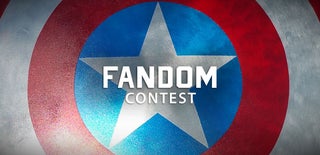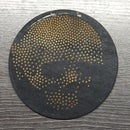Introduction: Alien Star Wars MashUp
As a child of the 80s I am a big Star Wars and Alien fan. Those movies still have an impact on me.
But before we start, if you like this little project, PLEASE VOTE for my instructable in the FANDOM Contest. THX!
When I came across the template of Paul Braddock while browsing the net, I had the idea to combine it with a Facehugger. But how? I don't have the skills to draw something like that by far. On Thingiverse I came across a template that separated every element of the Facehugger. Couldn't you then take each part and put it together "somehow"? Yes, you could. With much patience and a misuse of the slicer software.
The whole project consumed a lot of time. It went on for many weeks and a lot of my attempts with different techniques failed.
In the end I made more or less everything with classical tools. Except the most obvious one: the 3D printer.
Very fine brushes, very fine paint, some putty. I tried (and failed) oil paint, chipping technique, polishing and a classic wash and adding highlights.
But I am very satisfied with the result. It only took me about three weeks longer than I thought.
Step 1: Puzzle
All the pieces of the Facehugger from here:
https://www.thingiverse.com/thing:2363902/files
And the helmet/skull from here:
https://www.myminifactory.com/...print-death-troop...
What's the trick?
Patience. You don't have to think a lot about size or orientation in advance. In the end, it's about the same size in all three directions. My object is about 7x7x7cm in size. We start with the helmet and put it in the middle in position. Then next the body of the Facehugger. Scale, position, rotate. Then the first parts of the finger. Scale again, position, rotate.
It took me about 4 hours. Surely you can do this in several other programs. But personally I only know a little bit about Simplify3D. Just enough to implement something like that.
I printed it with 0.15mm. With my Anycubic the printing took 14h. If I would do it again, I would print it bigger. Whether it prints 14h or 24h does not matter in the end.
The orientation is with the back of the helmet towards the printing bed. The supports are set by hand.
Step 2: Preparing the Surface
All support structures must be removed.
Some of them were inside and I had to use the dentist tools. The surface was treated with files and sandpaper. First and foremost it is about the helmet. The facehugger was later completely filled in with putty.
If everything is as smooth as you can get with sanding, the primer is applied to the object.
I have used plastic primer from spieß hecker. This is solvent-based and the smell alone seems carcinogenic.
Step 3: Filling and Sanding
As before, it's all about the helmet. Especially in the back it had to be filled properly. But also in front, because not all printer lines could be sanded away.
Filling, sanding ... putty once more ... sanding further. Until you have a smooth result. Then I applied acrylic filler. It is quite thick and sprays like artificial snow from a spray can. But it does not cover the 0.15mm completely.
I also sprayed it a bit too thick. You can see this by the "orange skin" (this is an expression for slightly uneven surfaces after painting).
So what's next? Sanding and filing again.
The aim is to get a surface that could be painted to a high gloss.
I sanded with sandpaper from 200 up to 400 and later to the end also with 1000s. And here and there also with steel files.
Step 4: First "real" Layer
Since this is one of the most beautiful moments, I have dedicated a separate step to it in this manual.
The first real application of paint. I currently recommend acrylic paint from Cosmos. If you put it into a warm water bath before, the paint mist will be superfine. The coverage is terrific. For acrylic it is even very shiny. Enjoy the moment. And maybe you want to leave your object exactly like this. Because from now on there will be many opportunities to ruin it.
From this layer on you should no longer use materials on a 2-component basis. But we do it anyway.
Step 5: Skin and Bones
For the base color at the open skull parts I mixed a very weak yellow. It is important to apply all colours only by glazing. This gives a depth in the colour which is simply not possible with solid colours.
First I drew the border "skull | helmet" with a pure red.
Then with very short brush strokes I applied a red, watery, glaze. Through the short strokes, the colour pigments in the glaze always migrate to the outside, like in a drop of water. This results in this somewhat harder edge on each brush stroke. In the end, you get something like a marbling, if you are lucky. After that, a slightly glazed darker red over the edge. Slightly wider than the first red and then always repainted with water to soften the transition. The edges of the helmet are applied more or less dry-brushed. I also added a drop of black to the "shallow" areas of the helmet damage, i.e. the corners that go really deep. This immediately gives more contrast and looks like really dry blood.
The bone edge is set punctually with the brush in dark red.
The inner elements, which should also be bloody, are made with three shades of red and some black.
Step 6: Helmet
With the helmet I started with the visor. This is the only part that is not painted. I used black, high-gloss foil. To do this, I taped the part, stripped it off, reapplied it, cut it and repeated several times until it fit.
I "taped" the blue elemts with "Rubbermasking from Schmincke". Everything else is applied freehand with a brush. Three different greys and some black.
At this point, you should still work as if you want it to look perfect and clean at the end. So without any damage or other traces of wear.
The weathering is done much later.
Step 7: Facehugger Part 1
The Facehugger was completely drawn in with putty. I used "Nigrin Fine Filler". Solvent-based. This immediately dissolved the primer.
It hardens again, but at first you assume that you have ruined everything now.
Due to the curing times, the whole filling process took many days. Filling, letting it harden, sanding, filling again ... and so on.
I have used 5 layers including sanding and shaping. From the third layer on I started to form with the dental tools. The bumps have all been shaped a little bit. The joints, or the attachments to them, have also been shaped.
Step 8: Facehugger Part 2: Colors
The whole alien should get a skin tone. This skin should look a bit sick and also thin in some places.
A good clue are your own knuckles.
So the base is a very thin, slightly dirty yellow. The putty absorbs the paint very quickly. And the colour tone changes continuously. And the putty also gets a few cracks. This all sounds like a catastrophe, but the opposite is true. This dynamic creates the organic look.
Method:
2x glazed with the same colour.
But I started undiluted in the still a bit too light areas. The still wet paint then with diluted paint a little bit spread.
Afterwards I added some red to the glaze to make the tone itself a bit warmer. And at the same time a bit darker to create saturation. I started at the fingertips. Nail polish for the Facehugger. Then along the edges of the fingers and all the hollows.
The method is to work from back/underneath to the front. Basically like a contrast line/outline to emphasize the front colors.
And what I had completely forgotten was the back of the lower lobes.
It is now painted pure with the reddish glaze. On the level that's enough, too. But if necessary -> a second layer on the lobes.
Step 9: Facehugger Part 3: Black
Now the Facehugger only lacks a little structure. The colors look good in themselves, but lack contrast. Black brings volume.
Otherwise you use black for a wash to bring out fine details. Effectively you shear color in scratches. This is not possible here, because there are hardly any scratches. And the putty still absorbs the colour.
Fine color is the key. And this very much diluted. You could almost talk about dirty water. And ideally in 3 or 4 shades. The last one being water.
I shaded five times until I thought it was enough.
Step 10: Facehugger Part 4: Gloss
Even if this step is done quickly, you should be aware that after applying the paint no more changes are possible.
The acrylic-paint should have been dry for a few days. The "acrylic varnish from Schmincke" can be applied more or less like oil. It has a very good flow. But you should test it in any case on another object. After days only with acrylic this color is something completely different.
The varnish is also very well suited to make the blood look wet. You should not exaggerate this, but at the spots where blood would accumulate, it gives just the right effect.
Step 11: Weathering: Helmet
In order to make the helmet appear a little less clean, the shine must first be removed. I got this with 1000 grit sandpaper.
Afterwards I removed some paint in several places. Here it was originally planned to use the chipping technique. Then here and there with the scalpel fine hairline cracks worked in. All new cracks were then sanded down with 1000 grit paper so that the edges of the cracks did not interfere. Afterwards again with the black glazes on the helmet. At some point you have reached the point: now it is enough.
Every little scratch on the photos is set and reworked by hand.
Step 12: Finishing / Extras
For the small valves at the front of the helmet I have come up with a little something. I removed the fine wire meshes from an ultrasonic measuring device of an Arduino kit. Then cut them with scissors. A circle of about 1mm. And pasted them on the exits. Then painted over several times. These are details that are hardly visible to the eye. But...
For the stand I simply used spruce. 80x80x25mm. The edges chamfered with the router. Then black varnished with wood stain. The helmet is glued with black hot glue at three points. Under the wood are 4 silicone stoppers.
Step 13: Final Pictures
And some last pictures.
I hope you enjoy the whole project. If YES, then please vote for me in the fandom contest.
Thank you for reading,
don
P.S.: the whole story of its creation can be read in German in my new forum "maker-forum.net". It can also be found at kodinerds.net.
I can't give you an *.STL, because there is no STL made. You have to make it in your own slicer.

Runner Up in the
Fandom Contest













